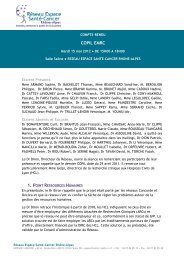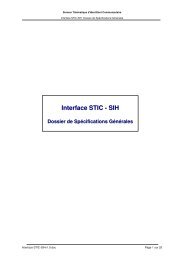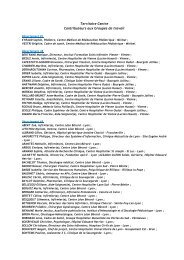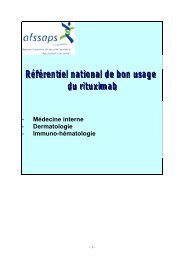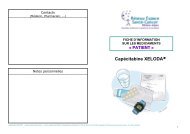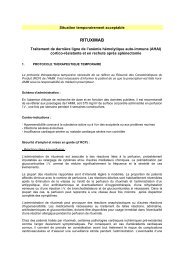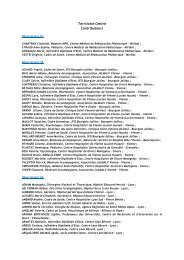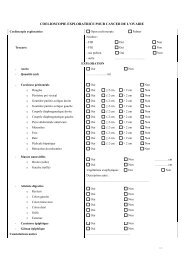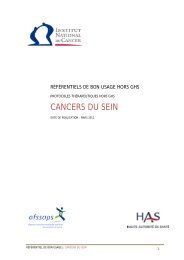Maladie du greffon contre l'hôte (GVHD)
Maladie du greffon contre l'hôte (GVHD)
Maladie du greffon contre l'hôte (GVHD)
You also want an ePaper? Increase the reach of your titles
YUMPU automatically turns print PDFs into web optimized ePapers that Google loves.
Situation temporairement acceptable<br />
RITUXIMAB<br />
<strong>Maladie</strong> <strong>du</strong> <strong>greffon</strong> <strong>contre</strong> l’hôte (<strong>GVHD</strong>) chronique en échec d’une<br />
bithérapie immunosuppressive bien menée<br />
1. PROTOCOLE THERAPEUTIQUE TEMPORAIRE<br />
Le protocole thérapeutique temporaire nécessite de se référer au Résumé des Caractéristiques <strong>du</strong><br />
Pro<strong>du</strong>it (RCP) de l’AMM. Il est nécessaire d’informer le patient de ce que la prescription est faite hors-<br />
AMM sous la responsabilité <strong>du</strong> médecin prescripteur.<br />
Schéma d’administration :<br />
En l’absence d’étude de recherche de dose et en fonction des données publiées, il est recommandé<br />
de se référer aux posologies de l’AMM, soit 375 mg/m² de surface corporelle administrés en perfusion<br />
I.V., une fois par semaine pendant 4 semaines consécutives.<br />
Contre-indications :<br />
- Hypersensibilité connue à la substance active ou à l’un des excipients ou aux protéines murines<br />
- Infections sévères évolutives<br />
- Insuffisance cardiaque sévère ou maladie cardiaque sévère non contrôlée<br />
Sécurité d’emploi et mises en garde (cf RCP) :<br />
- Réactions liées à la perfusion :<br />
L’administration de rituximab est associée à des réactions liées à la perfusion, probablement<br />
imputables au relargage de cytokines et/ou d’autres médiateurs chimiques. La prémédication par<br />
glucocorticoïdes I.V. permet de ré<strong>du</strong>ire significativement la fréquence et la sévérité de ces<br />
événements.<br />
La plupart des réactions rapportées sont d’intensité légère à modérée. La proportion de patients<br />
affectés diminue avec le nombre de perfusions. Les réactions décrites sont habituellement réversibles<br />
après la diminution de la vitesse ou l’arrêt de la perfusion <strong>du</strong> rituximab et l’administration d’un<br />
antipyrétique, d’un antihistaminique et éventuellement d’oxygénothérapie, d’une réhydratation<br />
veineuse ou d’une injection I.V. de bronchodilatateurs et de glucocorticoïdes si nécessaire. Dans la<br />
plupart des cas, la perfusion peut reprendre à une vitesse deux fois moindre après disparition<br />
complète des symptômes.<br />
L’administration de rituximab peut provoquer des réactions anaphylactiques ou d’autres réactions<br />
d’hypersensibilité. Les médicaments nécessaires au traitement de telles réactions, adrénaline,<br />
antihistaminiques et glucocorticoïdes, doivent être disponibles pour usage immédiat dans l’éventualité<br />
d’une réaction allergique pendant la perfusion de rituximab.<br />
Chez des patients traités par rituximab, certaines pathologies cardiaques ischémiques pré-existantes<br />
comme l’angor deviennent symptomatiques. Par conséquent, en cas d’antécédents cardiaques<br />
connus, il convient de prendre en considération avant tout traitement le risque de complications<br />
cardiovasculaires et d’assurer une surveillance étroite pendant l’administration. L’éventualité d’une<br />
- 7 -
hypotension pendant la perfusion de rituximab doit faire envisager l’arrêt <strong>du</strong> traitement<br />
antihypertenseur 12 heures avant la perfusion.<br />
- Infections :<br />
Le résumé des caractéristiques <strong>du</strong> pro<strong>du</strong>it (RCP) de rituximab, commercialisé depuis 1997, a été<br />
modifié en 2006 pour y inclure des données post-AMM sur des cas d'infections virales graves, dont la<br />
leucoencéphalopathie multifocale progressive (LEMP) chez des patients atteints de lymphome. De<br />
très rares cas de LEMP (
Allaitement : Le passage dans le lait maternel n’est pas connu. Cependant les IgG maternelles<br />
passent dans le lait, et le rituximab a été détecté dans le lait maternel chez le singe. En conséquence,<br />
les femmes ne doivent pas allaiter pendant le traitement par rituximab et pendant 12 mois suivant son<br />
arrêt.<br />
Nous vous rappelons que tout effet indésirable grave ou inatten<strong>du</strong> doit être déclaré au Centre<br />
Régional de Pharmacovigilance dont vous dépendez (coordonnées disponibles sur le site internet<br />
www.afssaps.sante.fr ou sur les premières pages <strong>du</strong> Vidal).<br />
Ce protocole thérapeutique temporaire est limité à une <strong>du</strong>rée de 4 ans.<br />
2. ARGUMENTAIRE<br />
L’incidence de la <strong>GVHD</strong> chronique s’élève à 400-500 patients/an en France .La <strong>GVHD</strong> chronique<br />
ressemble dans son mode d’expression à certaines maladies systémiques.<br />
La <strong>GVHD</strong>c se pro<strong>du</strong>it chez environ 33 % des receveurs ayant reçu un <strong>greffon</strong> géno-identique, et chez<br />
49 % des receveurs ayant reçu un <strong>greffon</strong> non apparenté. Les facteurs de risque de survenue sont<br />
l'âge élevé <strong>du</strong> patient ou <strong>du</strong> donneur, le degré de compatibilité tissulaire, l'utilisation d'un <strong>greffon</strong> issu<br />
d'un donneur non apparenté, l'utilisation de CSP (cellules souches périphériques) par rapport aux<br />
CSM (cellules souches mé<strong>du</strong>llaires), la survenue d'une <strong>GVHD</strong>a préalable et des injections de<br />
lymphocytes <strong>du</strong> donneur. La déplétion en cellules T <strong>du</strong> <strong>greffon</strong> est associée à une incidence<br />
significativement plus basse de la survenue de <strong>GVHD</strong>a ou <strong>GVHD</strong>c. Environ 10 à 15 % des patients<br />
atteints de <strong>GVHD</strong>c meurent de complications liées à des infections, ou à l'immunosuppression.<br />
Une étude rétrospective (Zaja, 2007) sur 38 patients ayant une <strong>GVHD</strong> chronique depuis 23 mois [2-<br />
116 mois] a montré une amélioration globale des manifestations cliniques dans 65% des cas.<br />
Un essai ouvert (Cutler, 2006) mené chez 21 patients ayant une maladie chronique <strong>du</strong> <strong>greffon</strong> <strong>contre</strong><br />
l’hôte cortico-résistante traitée par 1 à 3 cycles de 4 semaines a montré une efficacité <strong>du</strong> rituximab<br />
avec 60% de réponse partielle et 10% de réponse complète. Le rituximab a permis de ré<strong>du</strong>ire la dose<br />
de prednisolone de 40 à 10 mg/j.<br />
Toutes les séries de cas montrent une amélioration avec un pourcentage de répondeurs > 50% sans<br />
problème de tolérance particulier.<br />
Trois essais cliniques sont en cours : un essai clinique évalue le rituximab dans le traitement curatif de<br />
la <strong>GVHD</strong> chronique. Deux essais cliniques évaluent le rituximab en prophylaxie de la <strong>GVHD</strong> chronique<br />
après greffe de moëlle.<br />
En raison de la gravité de la maladie et malgré un faible niveau de preuve, l’utilisation <strong>du</strong> rituximab<br />
parait temporairement acceptable dans le traitement de la <strong>GVHD</strong> chronique en échec d’une bithérapie<br />
immunosuppressive bien menée.<br />
- 9 -
Effet <strong>du</strong> rituximab dans la maladie <strong>du</strong> <strong>greffon</strong> <strong>contre</strong> l’hôte<br />
Auteur<br />
principal<br />
Type d’étude Posologie Suivi Critères<br />
d’évaluation<br />
Zaja<br />
(2007)<br />
Rétrospective<br />
N= 38<br />
<strong>GVHD</strong> réfractaire<br />
11 mois Réponse<br />
complète (CR):<br />
résolution des<br />
manifestations<br />
cliniques de<br />
l’organe<br />
impliqué<br />
Résultats<br />
CR : n=9 (24%)<br />
Amélioration significative :<br />
n=65%<br />
Survie à 2 ans : 76%<br />
Décès : n=8<br />
. progression de la maladie :<br />
n=3<br />
. rechute : n=1<br />
. infection : n=3<br />
. mort subite : n=1<br />
Cutler<br />
(2006)<br />
Ouverte<br />
N=21<br />
Rituximab :<br />
375 mg/m²/semaine<br />
pdt 4 semaines avec<br />
éventuel 2 ième ou 3 ième<br />
cycle<br />
15 mois<br />
[7.9-19.2]<br />
Réponse<br />
clinique<br />
(complète<br />
partielle)<br />
ou<br />
↓corticothérapie<br />
et<br />
immunosuppres<br />
seurs<br />
Répondeurs : n=14/21 (70%)<br />
Répondeurs complets : n=2/21<br />
(9.5%)<br />
↓ prednisone de 40 mg/jour à<br />
10 mg/jour (p=0.0001)<br />
Tolérance :<br />
EI infectieux : n=6/21 (28%)<br />
Ratanathar<br />
athorn<br />
(2003)<br />
Série de cas<br />
N=8<br />
<strong>GVHD</strong> réfractaire<br />
Rituximab :<br />
375 mg/m²/semaine<br />
pdt 4 semaines<br />
22 mois<br />
[104 à 846<br />
jours]<br />
Réponse<br />
clinique<br />
Répondeurs : n=4/8 (50%)<br />
Tolérance :<br />
Troubles respiratoires<br />
lors de l’injection n=1<br />
Canningavan<br />
Dijk<br />
(2004)<br />
Série de cas<br />
N=6<br />
<strong>GVHD</strong> réfractaire<br />
Rituximab :<br />
375 mg/m²/semaine<br />
pendant 4 semaines ;<br />
en cas de réponse<br />
incomplète 12<br />
semaines plus tard,<br />
2 ième voire 3 ième cycle<br />
de rituximab.<br />
? -Amélioration<br />
cutanée et de la<br />
cavité buccale<br />
à 8 et 12<br />
semaines après<br />
le traitement.<br />
- Biopsie<br />
cutanée 8<br />
semaines après<br />
la fin <strong>du</strong><br />
traitement<br />
- Taux Ig, bilan<br />
hépatique<br />
Efficacité :<br />
- Amélioration cutanée : n=5/6<br />
(83%)<br />
- Amélioration incomplète après<br />
1 er cycle : n=3/6 (50%)<br />
- Taux d’Ig non modifié après<br />
traitement<br />
- rechute hémopathie n=2/6 (à<br />
20 et 16 mois après traitement)<br />
Tolérance :<br />
pas de complications<br />
infectieuses<br />
- 10 -
Auteur<br />
principal<br />
Bornhaeus<br />
er<br />
(2004)<br />
Type d’étude Posologie Suivi Critères<br />
d’évaluation<br />
Abstract<br />
Etude cas- témoins<br />
(rituximab avant<br />
allogreffe de moëlle<br />
en prévention <strong>GVHD</strong><br />
chronique)<br />
N rituximab=44<br />
Rituximab :<br />
375 mg/m²/semaine<br />
pendant 4 à 8<br />
semaines<br />
24 mois<br />
(médiane)<br />
- Survie globale<br />
- Mortalité<br />
- Incidence<br />
<strong>GVHD</strong> aiguë et<br />
<strong>GVHD</strong><br />
chronique<br />
Résultats<br />
- Pas de différence significative<br />
sur la survie.<br />
- Incidence <strong>GVHD</strong> aigüe et<br />
chronique significativement plus<br />
élevée dans le groupe non<br />
prétraité par le rituximab (88%<br />
vs 63%, p=0.03 ; 52% vs 23%,<br />
p=0.02)<br />
Pas de donnée de tolérance<br />
Bibliographie<br />
Les référentiels de la Juste prescription <strong>du</strong> CEDIT (AP-HP), des Pharmaciens de CHU et des<br />
Hospices Civils de Lyon ont été les documents de base <strong>du</strong> travail bibliographique.<br />
La recherche bibliographique a été réalisée par interrogation systématique des banques de données<br />
Medline, Embase et Pascal. Elle a identifié préférentiellement les essais cliniques et les revues de<br />
synthèse publiés en langue française ou anglaise après janvier 1993.<br />
1- Zaja F, Bacigalupo A, Patriarca F, Stanzani M, Van Lint MT, Filì C, Scimè R, Milone G, Falda M, Vener C, Laszlo D,<br />
Alessandrino PE, Narni F, Sica S, Olivieri A, Sperotto A, Bosi A, Bonifazi F, Fanin R; GITMO (Gruppo Italiano Trapianto<br />
Midollo Osseo). Treatment of refractory chronic <strong>GVHD</strong> with rituximab: a GITMO study. Bone Marrow Transplant. 2007<br />
Aug;40(3):273-7.<br />
2- Cutler C, Miklos D, Kim HT, Treister N, Woo SB, Bienfang D, Klickstein LB, Levin J, Miller K, Reynolds C, Macdonell<br />
R, Pasek M, Lee SJ, Ho V, Soiffer R, Antin J, Ritz J, Alyea E. Rituximab for steroid-refractory chronic graft-vs.-host<br />
disease.Blood. 2006 March 21.<br />
3- Ratanatharathorn V, Ayash L, Reynolds C, Silver S, Reddy P, Becker M, Ferrara JL, Uberti JP. Treatment of chronic<br />
graft-versus-host disease with anti-CD20 chimeric monoclonal antibody. Biol Blood Marrow Transplant. 2003 Aug;<br />
8:505-11.<br />
4- Canninga-van Djik M., van der Straaten H., Fijnheer R., Sanders C., van den Tweel J., Verdonck L. Anti-CD20<br />
monoclonal antibody treatment in 6 patients with therapy-refractory chronic graft-versus-host disease. Blood 2004; 104<br />
(8); 2603-2606.<br />
5- Bornhaeuser M., Schwerdtfeger R., Kroschinsky F. Pretreatment with rituximab re<strong>du</strong>ces the incidence of chronic graftversus-host-disease<br />
after allogeneic stem cell transplantation in patients with B cell lymphoma. Blood 2004 ; 104 (11) :<br />
abstract 1233.<br />
Groupe de travail<br />
Pr SOCIE Gérard, hématologue, Paris<br />
Dr FRANÇOIS Sylvie hématologue, Angers<br />
Pr TRON François, immunologiste, Rouen<br />
Pr KESSLER Michèle, néphrologue, Nancy<br />
Pr SAMUEL Didier, hépatologue, Villejuif<br />
Dr GUILLEMAIN Romain, anesthésiste-réanimateur<br />
Paris<br />
Groupe de lecture<br />
Pr BLAISE Didier, immunologiste, Marseille<br />
Pr BUZYN LEVY Agnès, hématologue, Paris<br />
Pr DECONINCK Eric, hématologue, Besançon<br />
Pr DREYFUS François, hématologue, Paris<br />
Dr FOUILLARD Loïc, hématologue, Paris<br />
Pr GORIN Norbert-Claude, hématologue, Paris<br />
Pr IFRAH Norbert, hématologue, Angers<br />
Pr LEMOINE François, immunologiste, Paris<br />
Pr MICHALLET Mauricette, hématologue, Lyon<br />
Pr MILPIED Noël, hématologue, Bordeaux<br />
Dr REMAN Oumedaly, hématologue, Caen<br />
Dr ROCHA Vanderson, hématologue, Paris<br />
Pr TOURAINE Jean -Louis, immunologiste, Lyon<br />
Pr VERNANT Jean-Paul, hématologue, Paris<br />
- 11 -
Comité de qualification<br />
Pr CAULIN Charles, Président, thérapeutique, Paris<br />
Pr AULAGNER Gilles, pharmacien, représentant des<br />
HCL, Lyon<br />
Mme BONGRAND Marie-Claude, pharmacien,<br />
représentante des Pharmaciens de CHU, Marseille<br />
Dr DUMARCET Nathalie, Afssaps<br />
Dr CHASSANY Olivier, méthodologiste, Paris<br />
Mme FAUCHER-GRASSIN Joëlle, pharmacien,<br />
représentante des Pharmaciens de CHU Poitiers<br />
Pr LAVILLE Maurice, praticien hospitalier,<br />
représentant des HCL, Lyon<br />
Mme MONTAGNIER-PETRISSANS Catherine,<br />
pharmacien, représentante de la Juste prescription de<br />
l’AP-HP, Paris<br />
M. LIEVRE Michel, pharmacologue, Lyon<br />
Mme PIVOT, pharmacien, représentante des HCL<br />
Lyon<br />
Pr RICHÉ Christian, pharmacologue, Brest<br />
M. ROPERS Jacques, Afssaps<br />
Dr ROSENHEIM Michel, médecin de santé publique,<br />
Paris<br />
Pr VICAUT Eric, médecin de santé publique, Paris<br />
La Commission d’AMM <strong>du</strong> 8 Novembre 2007 présidée par le Pr Daniel VITTECOQ n’a pas émis<br />
d’objection à ce référentiel, qui a également été visé par la Commission de la transparence de la<br />
HAS, présidée par le Pr Gilles BOUVENOT.<br />
Résumés-abstracts<br />
Zaja F, Bacigalupo A, Patriarca F, Stanzani M, Van Lint MT, Filì C, Scimè R, Milone G, Falda M, Vener C, Laszlo<br />
D, Alessandrino PE, Narni F, Sica S, Olivieri A, Sperotto A, Bosi A, Bonifazi F, Fanin R; GITMO (Gruppo Italiano<br />
Trapianto Midollo Osseo). Treatment of refractory chronic <strong>GVHD</strong> with rituximab: a GITMO study. Bone Marrow<br />
Transplant. 2007 Aug;40(3):273-7.<br />
The anti-CD20 chimaeric monoclonal antibody Rituximab has recently been shown to in<strong>du</strong>ce significant clinical<br />
response in a proportion of patients with refractory chronic graft-versus-host disease (c<strong>GVHD</strong>). We now report 38<br />
patients, median age 48 years (22-61), receiving Rituximab for refractory c<strong>GVHD</strong>, assessed for clinical response<br />
and survival. Median <strong>du</strong>ration of c<strong>GVHD</strong> before Rituximab was 23 months (range 2-116), the median number of<br />
failed treatment lines was 3 (range 1 to > or =6) and the median follow-up after Rituximab was 11 months (1-88).<br />
Overall response rate was 65%: skin 17/20 (63%), mouth 10/21 (48%), eyes 6/14 (43%), liver 3/12 (25%), lung<br />
3/8 (37.5%), joints 4/5, gut 3/4, thrombocytopaenia 2/3, vagina 0/2, pure red cell aplasia 0/1 and, myasthenia<br />
gravis 1/1. During the study period 8/38 died: causes of death were c<strong>GVHD</strong> progression (n=3), disease relapse<br />
(n=1), infection (n=3), sudden death (n=1). The actuarial 2 year survival is currently 76%. We confirm that<br />
Rituximab is effective in over 50% of patients with refractory c<strong>GVHD</strong> and may have a beneficial impact on<br />
survival.<br />
Cutler C, Miklos D, Kim HT, Treister N, Woo SB, Bienfang D, Klickstein LB, Levin J, Miller K, Reynolds C,<br />
Macdonell R, Pasek M, Lee SJ, Ho V, Soiffer R, Antin J, Ritz J, Alyea E. Rituximab for steroid-refractory chronic<br />
graft-vs.-host disease. Blood. 2006 March 21.<br />
B cells may be implicated in the pathophysiology of chronic <strong>GVHD</strong>, as evidenced by antibody pro<strong>du</strong>ction against<br />
sex-mismatched, Y chromosome-encoded minor HLA antigens in association with chronic <strong>GVHD</strong>. We therefore<br />
designed a phase I-II study of anti-B cell therapy with rituximab in steroid-refractory chronic <strong>GVHD</strong>. Twenty-one<br />
patients were treated with thirty-eight cycles of rituximab. Rituximab was tolerated well, and toxicity was limited to<br />
infectious events. The clinical response rate was 70%, including two patients with complete responses.<br />
Responses were limited to patients with cutaneous and musculoskeletal manifestations of chronic <strong>GVHD</strong> and<br />
were <strong>du</strong>rable through one year after therapy. The median dose of prednisone among treated subjects fell from 40<br />
mg/day to 10 mg/day, one year after rituximab therapy (p=0.0001). A chronic <strong>GVHD</strong> symptom score improved in<br />
the majority of treated patients. Antibody titers against Y chromosome-encoded minor HLA antigens fell and<br />
remained low while titers against infectious antigens (EBV, tetanus) remained stable or rose <strong>du</strong>ring the treatment<br />
period. We conclude that specific anti-B cell therapy with rituximab may be beneficial for patients with steroidrefractory<br />
chronic <strong>GVHD</strong>.<br />
Ratanatharathorn V, Ayash L, Reynolds C, Silver S, Reddy P, Becker M, Ferrara JL, Uberti JP. Treatment of<br />
chronic graft-versus-host disease with anti-CD20 chimeric monoclonal antibody. Biol Blood Marrow Transplant.<br />
2003 Aug; 8:505-11.<br />
We reviewed the clinical outcome of 8 patients with steroid-refractory chronic graft-versus-host disease (<strong>GVHD</strong>)<br />
who received an anti-CD20 chimeric monoclonal antibody (rituximab). Rituximab was given by intravenous<br />
- 12 -
infusion at a weekly dose of 375 mg/m² for 4 weeks. All patients had received extensive treatment with various<br />
immunosuppressive agents; 6 patients had also received extracorporeal photopheresis. All patients had extensive<br />
chronic <strong>GVHD</strong> with diffuse or localized sclerodermoid <strong>GVHD</strong> and xerophthalmia. Other extracutaneous<br />
involvements included cold agglutinin disease with the Raynaud phenomenon, membranous glomerulonephritis,<br />
and restrictive or obstructive lung disease. Four patients responded to treatment with ongoing resolution or<br />
improvement ranging from 265 to 846 days after therapy, despite recovery of B cells in 3 patients. Rituximab<br />
seems to have significant activity in the treatment of refractory chronic <strong>GVHD</strong> and should be considered for<br />
further study in patients with early disease. This study suggests a participating role of B cells in the pathogenesis<br />
of chronic <strong>GVHD</strong>.<br />
Canninga-van Djik M., van der Straaten H., Fijnheer R., Sanders C., van den Tweel J., Verdonck L. Anti-CD20<br />
monoclonal antibody treatment in 6 patients with therapy-refractory chronic graft-versus-host disease. Blood<br />
2004; 104 (8); 2603-2606.<br />
Chronic graft-versus-host disease (c<strong>GVHD</strong>) is an important determinant of long-term morbidity and mortality in<br />
allogeneic stem cell transplantation patients. Because c<strong>GVHD</strong> has clinical, histologic, and laboratory findings of<br />
autoimmune diseases and anti-B-cell therapy has shown efficacy in autoimmune diseases, we hypothesized that<br />
monoclonal anti-CD20 antibody therapy might improve patients with c<strong>GVHD</strong>. We treated 5 men and 1 woman<br />
with therapy-refractory extensive c<strong>GVHD</strong> with anti-CD20 monoclonal antibody. Intravenous infusion was given at<br />
a weekly dose of 375 mg/m(2) for 4 weeks. In case of incomplete clinical response, additional courses of 4 weeks<br />
were given. Five patients responded to treatment with marked clinical, biochemical, and histologic improvement.<br />
One patient failed to respond. Anti-CD20 monoclonal antibody seems to be effective in c<strong>GVHD</strong>. A controlled trial<br />
is mandatory to confirm these results. The outcome of this study suggests a participating role of B cells in the<br />
pathogenesis of c<strong>GVHD</strong>.<br />
Bornhaeuser M., Schwerdtfeger R., Kroschinsky F. Pretreatment with rituximab re<strong>du</strong>ces the incidence of chronic<br />
graft-versus-host-disease after allogeneic stem cell transplantation in patients with B cell lymphoma. Blood 2004 ;<br />
104 (11) : abstract 1233.<br />
The use of anti-B cell antibodies before allogeneic hematopoietic stem cell transplantation (HSCT) in<strong>du</strong>ces a<br />
depletion of recipient B cells. This leads to a re<strong>du</strong>ction of the number of potential antigen presenting cells and<br />
thereby might hamper the in<strong>du</strong>ction phase of graft-versus-host disease (GvHD). The humanized anti-CD20<br />
antibody Rituximab has been used with increasing frequency to treat patients with B cell Non-Hodgkin’s<br />
Lymphoma. Only recently, several investigators have reported on the efficacy of Rituximab for the treatment of<br />
chronic GvHD. We therefore hypothesized, that patients who received Rituximab before being sche<strong>du</strong>led for<br />
allogeneic HSCT may have a decreased risk of GvHD. A retrospective analysis in 72 patients after allogeneic<br />
hematopoietic stem cell transplantation for indolent (n=18), aggressive (n=45) B cell lymphoma or mantle cell<br />
lymphoma (n=9) was performed at two centres. Whereas 28 patients had received chemotherapy only before<br />
allogeneic HSCT, 44 patients had received 4-8 (median 6) cycles of 375 mg/m2 Rituximab before the start of<br />
conditioning therapy. Patient characteristics’ were comparable except for a higher proportion of unrelated donors<br />
(73% vs. 54%) and a higher median age (48 vs. 42 years) in the cohort with Rituximab pre-treatment. In addition<br />
the proportion of patients having received a previous autologous transplantation was higher (63% vs. 46%) and<br />
therefore more recipients received dose re<strong>du</strong>ced conditioning before allogeneic tranplantation (70% vs. 50%) in<br />
the Rituximab group. With a median follow-up of 24 months for all patients, no significant differences in overall<br />
survival, progression-free survival and treatment-related mortality could be detected between both groups.<br />
Although the proportion of transplants from unrelated donors was lower in the No-Rituximab group, the rate of<br />
acute GvHD grade I-IV was higher (88% vs. 63%, p=0.03). The incidence of grade II-IV and grade III-IV GvHD<br />
was not significantly different between both cohorts. Chronic GvHD occurred more often in patients who had not<br />
received Rituximab before allogeneic transplantation (52% vs. 23%, p=0.02).Although the retrospective nature of<br />
our study does not allow to draw definitive conclusions, the rate of chronic GvHD seems to be lower when anti-<br />
CD20 treatment is performed before allogeneic HSCT. Prospective studies incorporating Rituximab for the<br />
prophylaxis and therapy of GvHD are warranted.<br />
- 13 -



